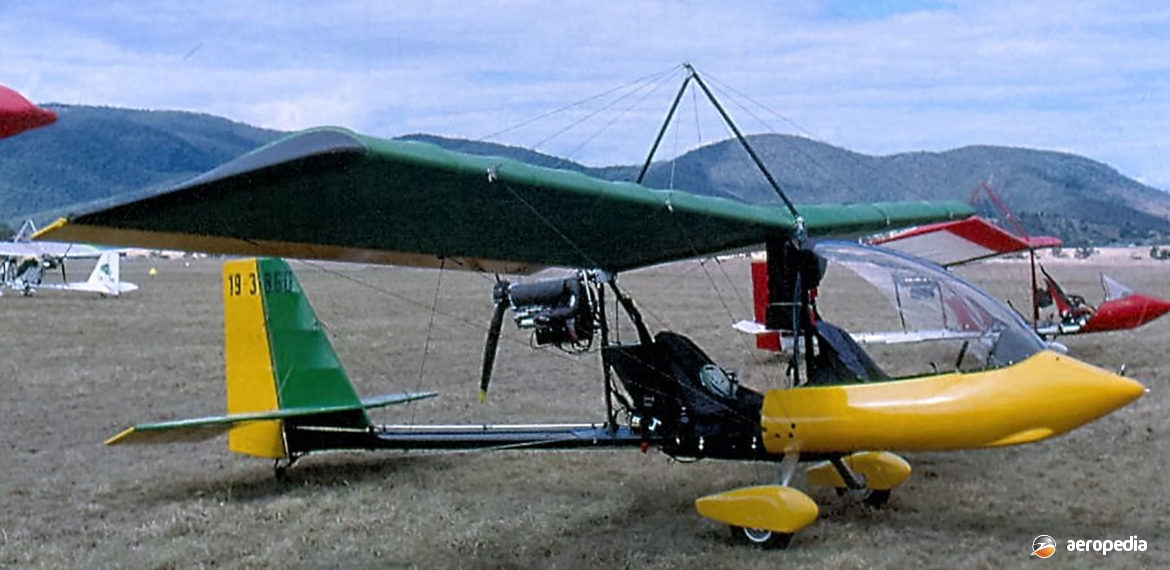Photograph:
Fisher Aero Horizon Mk 1 19-3860 (c/n 017) at Watts Bridge, QLD in 2010 (David C Eyre)
Country of origin:
Australia
Description:
Single or two-seat light aerobatic ultralight aircraft
Power Plant:
One 37 kw (50 hp) Rotax 503UL-2V two-cylinder, two-stroke, fan-cooled engine with electronic dual-ignition
Specifications:
- Wingspan: 9.1 m (29 ft 9 in)
- Length: 6.3 m (20 ft 8 in)
- Height: 2.77 m (9 ft 1 in)
- Wing area: 14.1 m² (151.77 sq ft)
- Cruising speed at 75% power: 111 km/h (69 mph)
- Rate of climb at sea level: 229 m/min (750 ft/min)
- Stalling speed: 59 km/h (37 mph)
- Fuel capacity: 30 litres (6.6 Imp gals)
- Empty weight: 150 kg (331 lb)
- Max loaded weight full fuel: 186 kg (410 lb)
- Loaded weight: 357 kg (787 lb)
History:
Spectrum Aviation was formed at Lismore, NSW in 1989 as an ultralight maintenance, flight training and sail manufacturing facility. It also became involved in the restoration and repair of ultralight aircraft. The owner/operator Wayne Fisher has been involved in hang-gliders and ultralights for many years as both a pilot and instructor and has been involved in the construction of many ultralight aircraft. He has designed, developed and built the Fisher Mk I as a single or two-seat ultralight with optional dual controls. It was a pod and boom aircraft with a high wing and was wire braced. It was available in kit form, and was usually fitted with the Rotax 503 engine, but the 912 of 60 kw (80 hp) engine and the Rotax 582 engine providing 48 kw (65 hp) from that manufacturer could also be installed. An Ivo or Brolga three-blade propeller of 1.524 m (60 in) diameter was usually fitted.
The Fisher Mk 1 Aerobatic was an ultralight but purpose-built aircraft registered in the general aviation category under the Experimental Rules as Civil Aviation Safety Authority (CASA) did not permit ultralight aircraft to perform aerobatics. Similar in appearance to the Drifter series, the Fisher Mk 1 was a two-seater and utilised a symmetrical aerofoil section but had a shorter wing and was lighter in weight. It met CAO 95-55 par.1.5 and was registered in the 51 per cent amateur-built aircraft category, or CAO 95-10 as a single-seater.
First example of the type registered in the general aviation category in this region was VH-VSI (c/n 008) in October 2001 at Lismore, and 19-4798 (c/n 028) was registered under Recreational Aviation Australia (RAA) Regulations. VH-VSI was cancelled from the civil register in early 2018. One example 19-3893 (c/n 020) was fitted with amphibious floats. Other examples have included 19-4097 (c/n 323), 19-3861 and 19-3860 (c/n 017) which following an accident at Ballina in 2014 was retired and has been placed on display at the Evans Head Aviation Heritage Centre.
Examples have also been completed in New Zealand, including ZK-LAC (c/n 154), a Mk I, and ZK-PDW (c/n HOR 2 1989), a Mk II.

